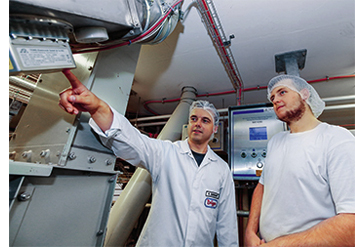Truth be told, it was a “byproduct” as its original purpose was to measure the moisture levels in extrudates during the production process. After a decision had been made to implement this system, the high potential offered by using it in the oat mill as well was also identified. Currently, moisture in the oat mill is measured in the laboratory. This means that someone must take a sample and run across the entire plant to take it to the laboratory, where it is analysed. Consequently, there is a long delay before the machinery operator can make any adjustments which may be necessary. This procedure will soon be relegated to the past as we have been able to install an innovative microwave system in the production line. Known as a “moisture measurement system”, it takes continuous individual measurements around 700 times a second. The measurement point is located directly in the product stream, thus ensuring that any deviations can be swiftly eliminated. The purpose is to ensure that the moisture of the oatmeal remains as close as possible to the target water content level of 12 percent in order to improve product and process stability. This means that less drying is necessary, thus lowering costs considerably.
The use of microwaves to measure moisture is an indirect measurement method, i.e. the water content is measured indirectly by utilizing a certain physical effect. Just like a kitchen microwave oven, the water molecules are caused to vibrate, albeit much more slowly. Consequently, the measurement process must be calibrated by reference to direct measurements; in our case this is the oven-dry method. The calibration ensures that the microwave value matches the value measured using the reference method. These changes are heavily influenced by the water content of the product.
“What is also important of course is the size of the individual particles which influence this. For this reason, we have calibrated nine different products made on the line,” explains Julia Podszuck. Apart from the size of the sensor, it was particularly difficult to find the right place to position it. Ultimately, however, a decision was made to integrate it in the OTW 4 line behind the fluidized bed dryer in the new muesli building at the level of the cereal mixing machine.
The project commenced 18 months ago with preliminary testing in the laboratory. Our technical staff then installed the necessary devices at the beginning of the year. In line with documentation requirements, our IT department made the necessary adjustments in the early summer to ensure that the requisite data can be stored over a protracted period of time. The figures are now displayed on the control panel and archived on the server.
Once the system has been fully rolled out, it will also be implemented in the two other production lines in the peeling mill to control constant moisture levels more swiftly and simply.
